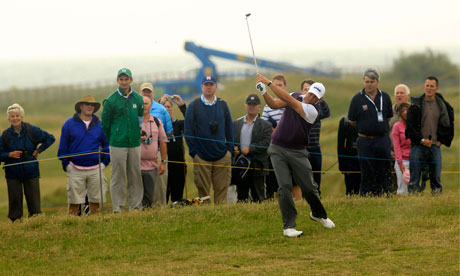Royal Porthcawl Gets Three Senior Open Championships
/ An Open seems unlikely, so it gets the next best thing with three Senior Opens, starting in 2014, with two more guaranteed between 2015 and 2024.
An Open seems unlikely, so it gets the next best thing with three Senior Opens, starting in 2014, with two more guaranteed between 2015 and 2024.When you come to think of it that is the secret of most of the great holes all over the world. They all have some kind of a twist. C.B. MACDONALD

 An Open seems unlikely, so it gets the next best thing with three Senior Opens, starting in 2014, with two more guaranteed between 2015 and 2024.
An Open seems unlikely, so it gets the next best thing with three Senior Opens, starting in 2014, with two more guaranteed between 2015 and 2024.Rex Hoggard catches up with Dave Stockton during his book tour stop at Golf Channel headquarters and asks about the belly putter.
“(Mickelson) is only going to get better at doing it. He’s got the eyes, he’s got the feel,” Stockton says. “With it anchored like that you’re only going to repeat (the stroke).”
To be clear, Stockton has no plans to convert to a long putter, nor would he advise one of his students to try one, at least not from the outset. In fact, he’s still not sure the long putter’s use should be legal, at least at the highest level.
“I’m old school. I don’t understand how you can anchor it on your body,” he says. “Nobody can tell me how Sam Snead’s croquet (putting style), where nothing is connected but just because you’re straddling your line is illegal, and then tell me (the belly putter) is legal.”
In this week's Golf World Monday, I explain who is most to blame for premature sign-offs of the unusual Walker Cup online coverage.
Courtesy of AP's Doug Ferguson, more of the kinder, gentler Acushnet CEO Wally Uihlein talking about the relationship between rulemakers and manufacturers.
The debate between tradition and technology has been around more than a century, and that is not likely to change. Uihlein said he can make an argument "for or against bifurcation" – different equipment rules for pros and amateurs – although that should not be an agenda that any manufacturer could promote.
"We still have a commercial genesis to that thought process," he said. "We can't argue that we have the best interest in the game. We can make that argument, but the fact is we represent the commercial landscape. And so, it doesn't matter how noble our argument is. It's still going to be seen as to some degree commercially prejudiced."
Uihlein said it's up to the R&A and the USGA to not only set the rules, but to assume greater responsibility in the game's future.
"If not, who does?" he said. "There's always going to be that question of whose game is it, and who's responsible for its perpetuation and sustenance."
 From Philip Reid's story, it sounds like R&A Secretary Peter Dawson is just quieting the building speculation as to prevent an all-out riot over Royal Portrush's prospects for an Open Championship rota return.
From Philip Reid's story, it sounds like R&A Secretary Peter Dawson is just quieting the building speculation as to prevent an all-out riot over Royal Portrush's prospects for an Open Championship rota return.
Bob Harig on the question of Portrush's prospects raised during Wednesday's R&A press conference. Peter Dawson:
Other tours and governing bodies now just throw up their hands, shrug their shoulders and give the "it's always been that way" answer to slow play questions.
Not for the R&A's Championship Committee head Jim McArthur, with a nice assist from Peter Dawson!
 I've noticed a recurring theme in a few stories about the course: the R&A addressed complaints by widening fairways and keeping the rough tame. Uh, let's give credit where credit is due: the Golf Gods have kept Sandwich dry and therefore, at least based on the player comments I could find, the course is going to present itself well thanks to the lack of tall grass lining the fairways that has become an R&A staple to slow down swelling driving distances.
I've noticed a recurring theme in a few stories about the course: the R&A addressed complaints by widening fairways and keeping the rough tame. Uh, let's give credit where credit is due: the Golf Gods have kept Sandwich dry and therefore, at least based on the player comments I could find, the course is going to present itself well thanks to the lack of tall grass lining the fairways that has become an R&A staple to slow down swelling driving distances.The higher the ball flight, the worse the landing on a fairway hillock, goes Peter Dawson's theory revealed yesterday in a story by John Huggan.
Now Mike Stachura has tracked down a professor who confirms. Fasten your seat belts!
But here's the bit that justifies Dawson's explanation of projectile motion. Basically, a projectile like a golf ball has two velocity components, a horizontal one and a vertical one, as Martin Brouillette, professor of mechanical engineering at the University of Sherbrooke and a member of the Golf Digest Technical Panel explains: "Assuming two cases with the same landing velocity but with different landing angles, the case with the steeper landing angle has a smaller horizontal velocity component, therefore a greater vertical velocity component. This greater vertical velocity component, upon interacting with a tilted landing surface, is more likely to produce a greater sideways velocity component."
Therefore, play the stinger...less sideways velocity component. Oh wait.
***** Stachura writes:
Of course, a ball that's rolling over those awkward angles is going to be dramatically affected; one that's flying by those humps and bumps won't be bothered by them at all.
Maybe we could read more about this theory in the USGA/R&A ball study? After all, we're 8 years in, I assume this theory is covered?
 The Guardian's Severin Carrell reports on the big change for St. Andrews. Naturally, despite the story describing the St. Andrews clubhouse, they ran a photo of...you guessed it...the R&A clubhouse, which is definitely not the St. Andrews Golf Club.
The Guardian's Severin Carrell reports on the big change for St. Andrews. Naturally, despite the story describing the St. Andrews clubhouse, they ran a photo of...you guessed it...the R&A clubhouse, which is definitely not the St. Andrews Golf Club.
The committee at the St Andrews Golf Club, which is run from a handsome Victorian mansion overlooking the greens and fairways of the fabled Old Course, has written to its 2,000 male members recommending that it admit women to the club. The club, founded in 1843, has warned its members that under the new Equality Act, the club could face prosecution for failing to allow women to join. Keeping the ban would be a "retrograde step" as it would mean women would also have to be barred from its clubhouse as guests.
Its past club captains and trustees had decided that allowing all members, regardless of their gender, to have full access to all its bars and facilities would be "the best way, in their opinion, of safeguarding the long-term wellbeing of St Andrews Golf Club", the members were told.
Down boy, down boy. Contain your enthusiam!
Geoff Shackelford is a Senior Writer for Golfweek magazine, a weekly contributor to Golf Channel's Morning


Copyright © 2022, Geoff Shackelford. All rights reserved.